
The Business Of WritingLet’s beef up your template toolbox Credit: Mitul Shah via Burst
Credit: Mitul Shah via Burst
Would you like to write articles that are good enough for big publications? Does putting together your next article require hours of time, mountains of willpower, and exchanging your first-born child for enough peace and quiet in the house to get it done? To make your life easier and pump out more articles, have a mix of article outline templates to reference.
Some of my template-based articles this year were for fancy mainstream media publications like Fast Company, Business Insider, and Entrepreneur. Others were more eccentric, like this pretty weird one I loved writing for Debugger. I personally published about 115 articles this year, and over 90% of them followed one of 9 recipes. In this article I’ll share my recipe book so you can start using them too.
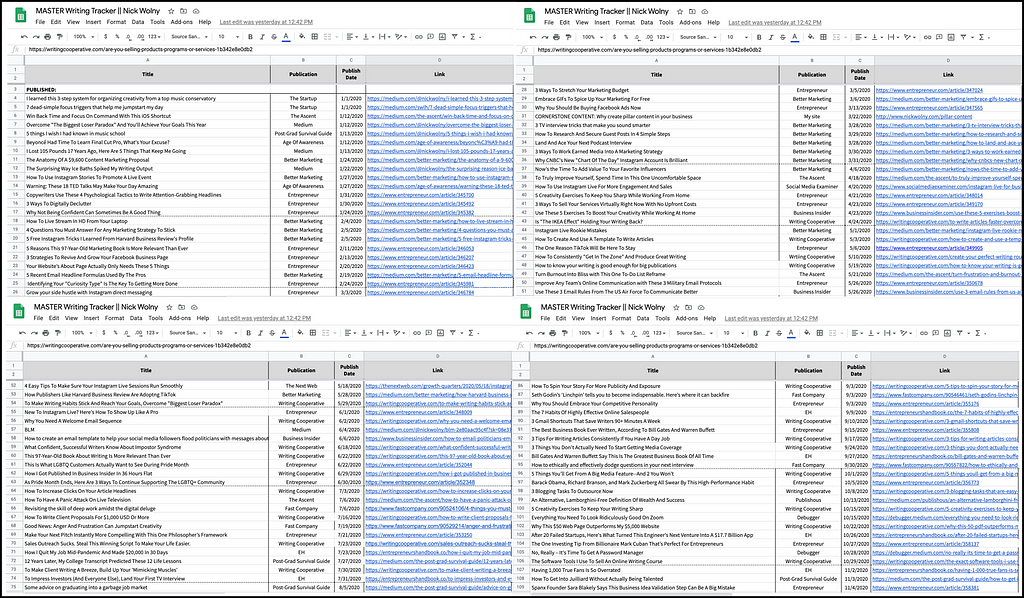 Screenshot from the author. Published articles in 2020Why care about having article templates?
Screenshot from the author. Published articles in 2020Why care about having article templates?
Whether it be to make extra money, attract a bigger audience, or simply express yourself via the written word, articles are one of the best ways to share your opinions and ideas. But despite having good intentions, many of our article ideas never see the light of day because we can’t quite get our thoughts organized. We remain stopped and stuck.
Templates and frameworks can fix that, and outlining articles is the single best way to organize your thoughts or ideas. Often, outlining your approach actually gets you more hyped about your idea. A study published in the Journal of Consumer Research confirms what you probably already know: Having a plan makes it more likely that you’ll achieve your goals.
 Image from the author.
Image from the author.
Grab a pen and paper, open your notes app, and let’s do this. Here are 9 templates to help you turn messy thoughts into crystal-clear articles.
Framework #1: Listicle
A listicle is any article that has a number in the title and is a cross between a list and an article. People either love ’em or hate ’em, and they can sometimes be considered lowbrow. In my opinion, the listicle is a great article format to start with; the goal of all of this is to practice and strengthen the musculature you use to organize thoughts and ideas.
In these framework images, I’m using some journalism shorthand. HED refers to your headline or title, DEK refers to your subheadline or subtitle, LEDE refers to the opening section, SUBHED refers to an intra-article subheadline, and TK stands for “to come” and denotes placeholders. These abbreviations are all purposely misspelled so that the letter combinations stick out to an editor.
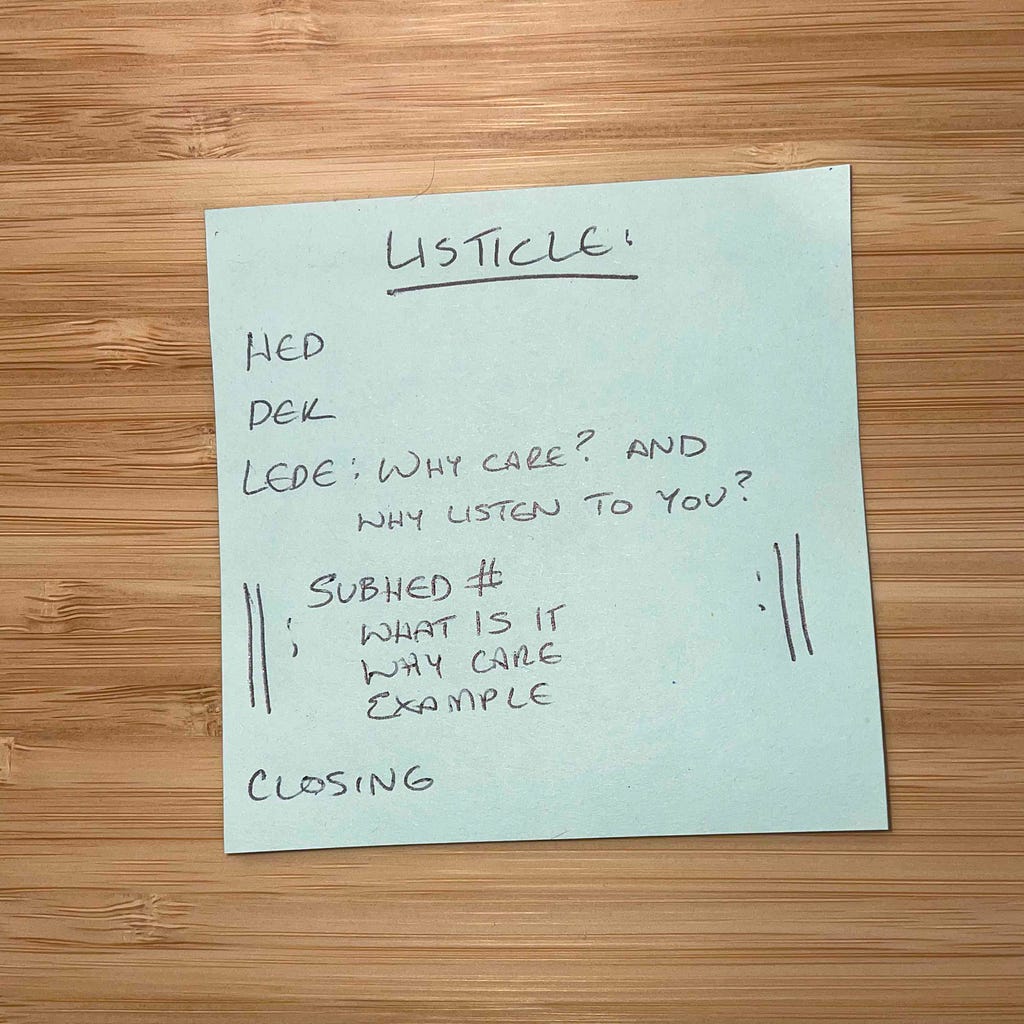 Image from the author.
Image from the author.
Those vertical train tracks with dots are actually “repeat bars”, like the ones you see in sheet music. I use them as shorthand to take up less space.
If you have a collection of tips or lessons, a listicle is one of the easiest ways to organize your thoughts. Listicles also often use a number in the title in numeral format (“3” rather than “three”) because numerals stick out and catch our eye. Here are a couple listicles of mine for reference.
3 Gmail Shortcuts That Save Writers 90+ Minutes A WeekUse these 5 exercises to boost your creativity while working at homeTakeaway: If you have a collection of tips or lessons, a listicle is one of the easiest ways to organize your thoughts.Framework #2: Listicle variation
Really Nick, another listicle template? You betcha. The above example is a bare-bones listicle. But there are times you may want to add context to your listicle before diving into your tips or sequence of steps.
If I were to write an article on how to cook vegetables, for example, I could give extra context right after the LEDE and remind readers why eating vegetables is a good idea in the first place. The article you’re reading right now is built from this second template; notice how, in the section above, I added a subhead and section about why you should care about templates. I could have left that out, but adding it adds some charge and ensures we’re all on the same page regarding intentions and goals.
 Image from the author.
Image from the author.
Here’s a visual of how a completed article constructed on the listicle variation template looks. In this article, I talk about Grice’s maxims, a concept from philosophy on how to make a message more clear. I open with why it’s important to make your message clear… but then I have to actually define Grice’s maxims before I start listing them off, yes? The extra SUBHED and section on context accomplish that.
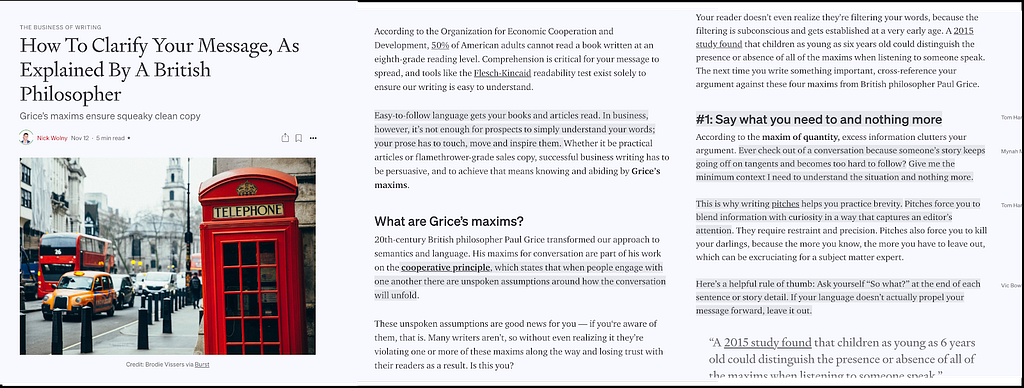
Get your reader excited about the information that is to come with a listicle variation. Then give it to them in a crunchy, easy-to-read format, and you have yourself an article that is a collection of ideas or steps but doesn’t feel like BuzzFeed.
How To Write Client Proposals For $1,000 USD Or More3 TV Interview Tricks That Make You Sound SmarterTakeaway: Get your reader excited about the information that is to come with a listicle variation.Framework #3: The popularity piggyback
If you’ve been reading content on this platform for more than twelve seconds, you’ve seen an article that follows this framework. Readers want to uncover the secrets of famous or established people in the hopes that they too might glean insights that will one day make them happy, healthy, or rich. Opportunistic writers see this and create content designed to elicit these desires.
Use the reputation of a famous figure or brand to capture attention, then maneuver into actionable advice the reader can start taking today. I think of it as a three-step formula. Here’s an example of that maneuvering in an article I wrote last month:
Spanx CEO Sara Blakely didn’t tell her friends or family about her prototype for an entire yearThat’s hard to do, because according to science, we’re biologically wired to crave validationHere are 3 things you can do today to validate a business idea without blabbing it to family and friends
The popularity piggyback is one of the most notorious and replicable ways to make an article go viral. It’s also helpful if you’re a boring person like me, because you don’t actually need an interesting or accomplished life. You just piggyback off of someone else’s. It’s good to practice composing already-known stories in your own unique writing voice. And as a bonus, the popularity piggyback usually gets a good response.
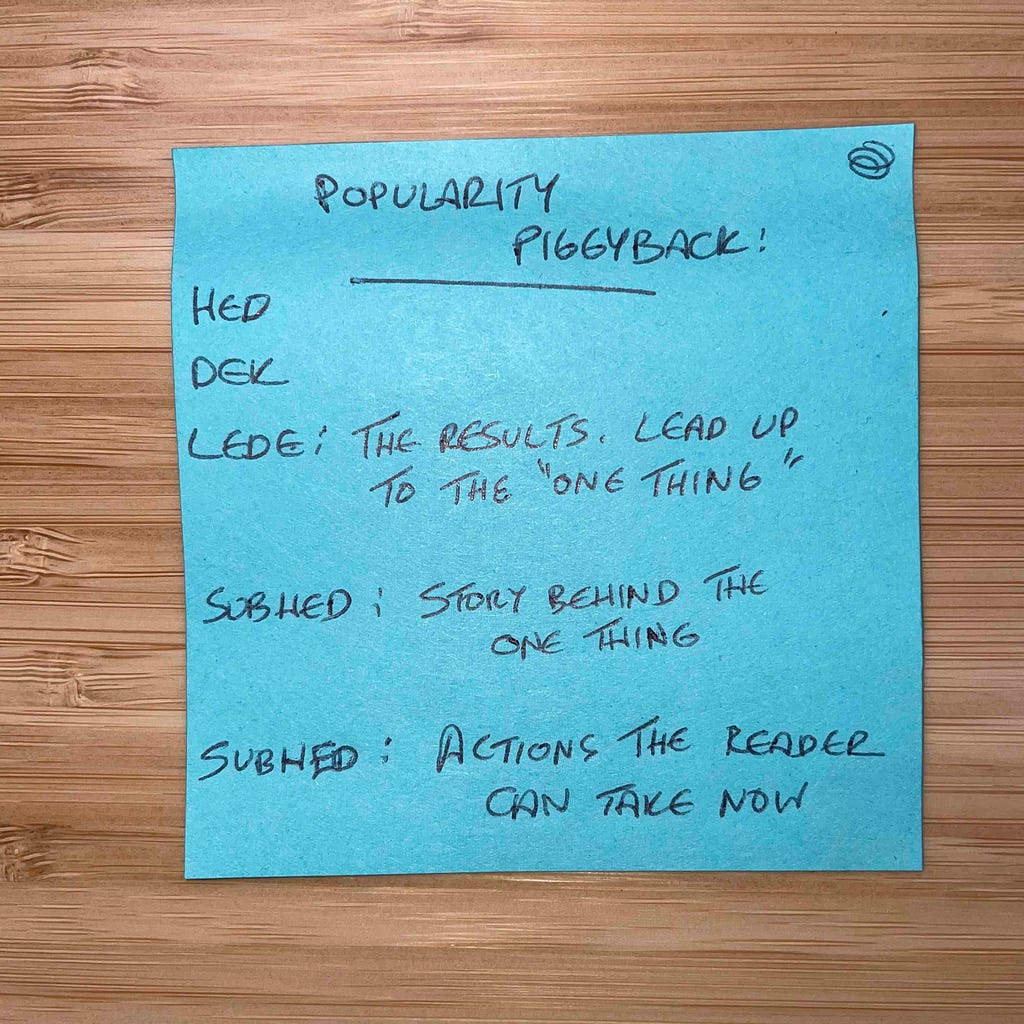 Image from the author.
Image from the author.
It’s probably becoming clear that you can also blend or combine these different frameworks. Here’s a nice article from Amardeep Parmar that shares about a famous person’s list of favorite books. As you become fluent in frameworks and hooks, you can start playing with them like legos, which is fun.
Spanx Founder Sara Blakely Says This Business Idea Validation Step Can Be A Big MistakeAfter 20 Failed Startups, Here’s What Turned This Engineer’s Next Venture Into A $17.7 Billion AppBill Gates And Warren Buffett Say This Is The Greatest Business Book Of All TimeTakeaway: It’s good to practice composing already-known stories in your own unique writing voice, and as a bonus, the popularity piggyback usually gets a good response.Framework #4: The expert/author piggyback
Speaking of books: Reviewing a book, TED talk, or body of work can absolutely be its own category of article content. To make things interesting, add another layer or dimension. Here’s a simple formula I often follow:
Existing expert’s content + specific takeaway or interpretation= article
These don’t even have to be books. Here’s one that nerded out on the work of Dr. Todd Kashdan, a researcher on curiosity. His research has found that people have different curiosity “types”, much like personality types. So when I covered it for Entrepreneur, I sprinkled in some analysis on how this information could be used for better productivity.
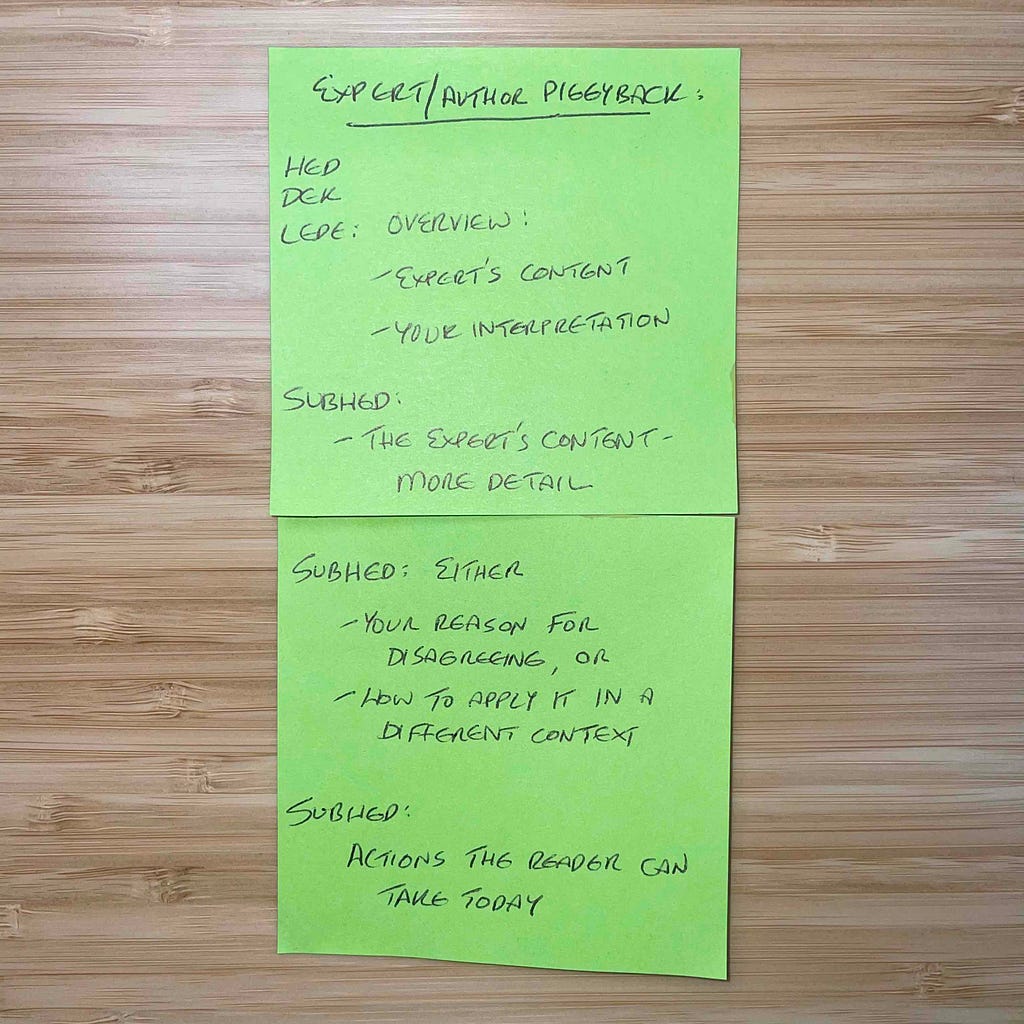 Image from the author.
Image from the author.
Look for ways to put an interesting or different spin on the experts and authors you already love. Start with experts you already follow and work your way up.
4 things you must do to achieve deep focus and get work done amid a digital delugeIdentifying Your 'Curiosity Type' Is the Key to Getting More DoneSeth Godin's 'Linchpin' tells you to become indispensable. Here's where it can backfireTakeaway: Existing expert’s content + specific takeaway or interpretation= article.Framework #5: Against-the-grain opinion“Different is better than better.” — Sally Hogshead
Is all the conversation in your industry the same? Are you so sick of seeing the same five tips over and over again? If you have experience or success with an unorthodox approach that would be surprising or controversial to readers, go against the grain. Strong opinion alone is enough to set you apart.
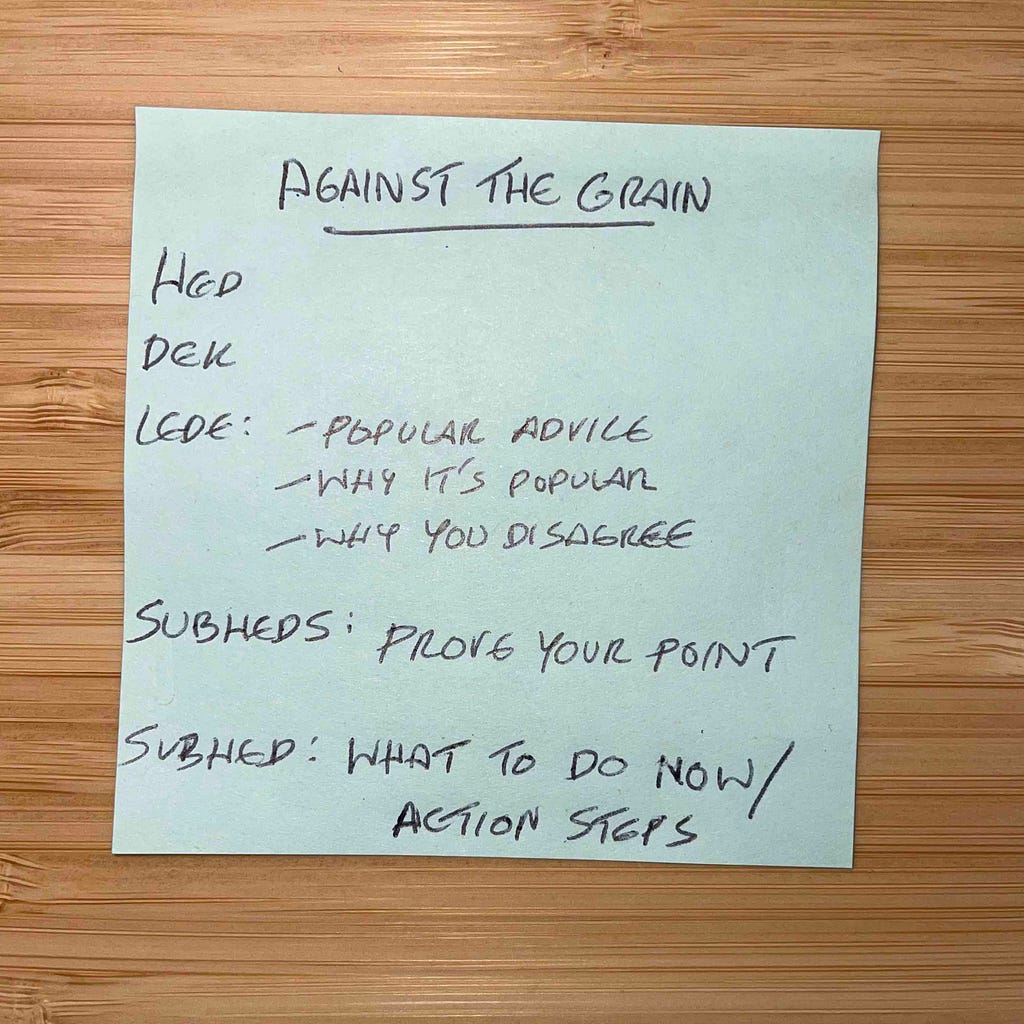 Image from the author.
Image from the author.
It’s better to have a sharp opinion that polarizes than a bland opinion no one cares about. Rustle up some courage and share your true opinions to attract a readership that appreciates your flavor.
Having 1,000 True Fans Is So Overrated“Facts Tell But Stories Sell” Is A LieTakeaway: It’s better to have a sharp opinion that polarizes than a bland opinion no one cares about.Framework #6: Old tips, new audience“What’s obvious to you is amazing to others.” — Derek Sivers
It’s good to write about a variety of topics for one audience. But why not flip the script and re-curate one topic to a variety of audiences? Explore how you can reference your tried-and-true tips in new ways to help or inspire different groups of people.
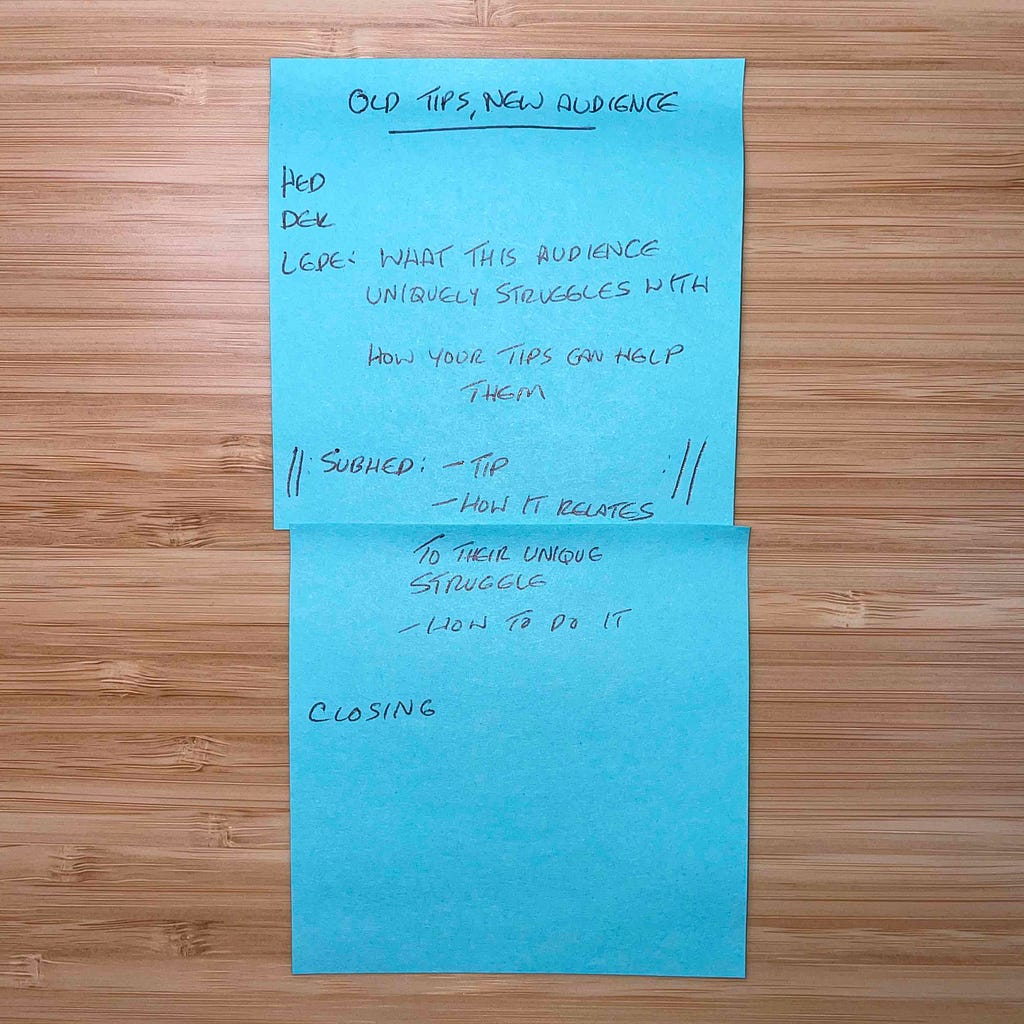 Image from the author.
Image from the author.
Explicitly define your audience in your headline. When you do this, your reader who is a part of that audience feels spoken to and will stop their scroll. For example, the bread-and-butter of my consulting business is working with small business owners on content. But there are loads of professionals who create content too while juggling a full-time job. I did it myself for years, and during that time I had to approach my writing efforts differently. Documenting the unique tweaks you make for your situation is totally an article.
3 Tips For Writing Articles Consistently If You Have A Day Job12 Years Later, My College Transcript Predicted These 12 Life LessonsTakeaway: Explore repeating your tried-and-true tips within changing frames to help or inspire different groups of people.Framework #7: Super-duper step-by-step
One media outlet I’ve written for in the past, Social Media Examiner, is an absolute content powerhouse. They slay on SEO and rank first-page for nearly every tutorial imaginable for all the major social media platforms. It took me two years to get a piece accepted into Social Media Examiner, and I still recall the rigorous specificity of the contributor guidelines:
One image every five paragraphs or lessImages must be cropped to include the social media interface at all timesEvery step of a step-by-step must have a corresponding image
It was so specific, but that’s also what makes their tutorials bulletproof. Readers read to feel inspired, and if you’re a facts-and-structure person like me, you like it when you discover a solution to your nagging problem in an easy-to-follow format. Write a tactical article with rigor and detail and you’ll see a magnetic response.
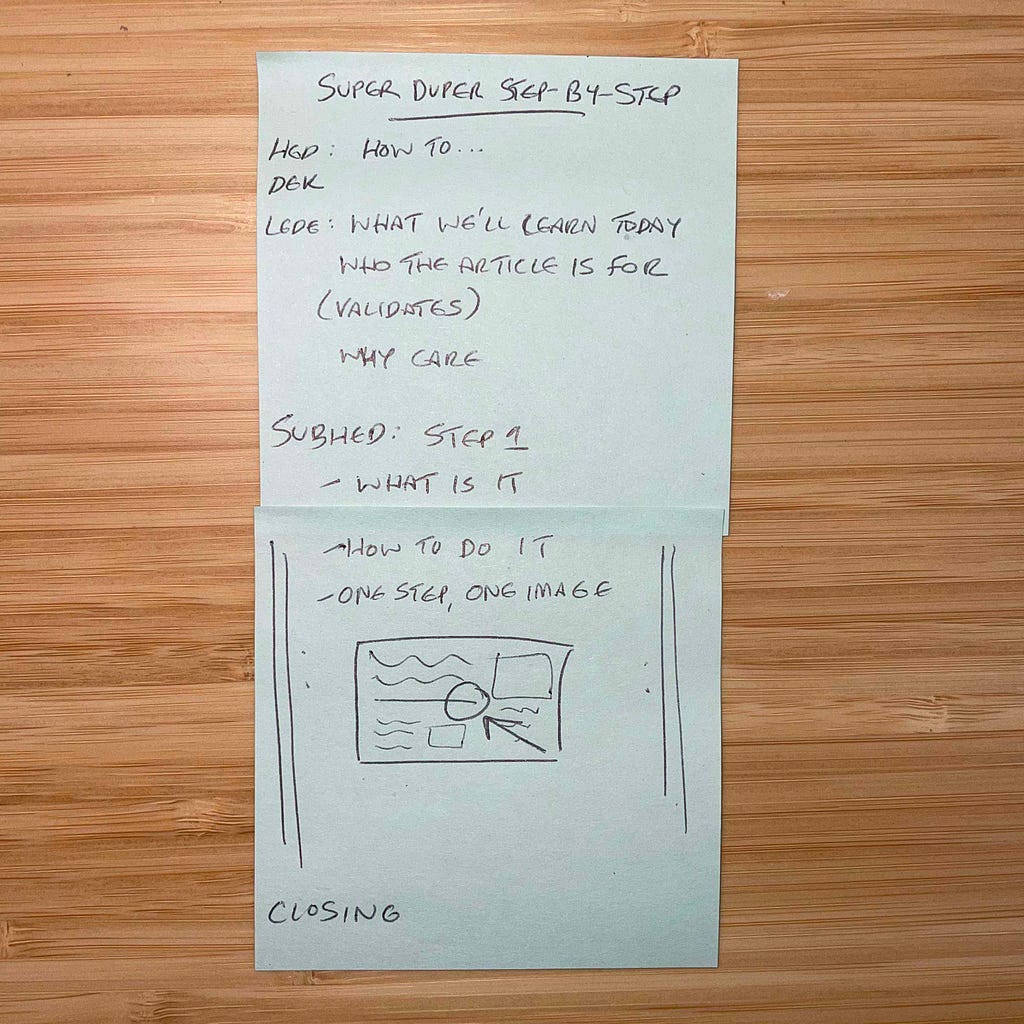 Image from the author.
Image from the author.
When I write this type of article, I blitz through a draft in a Google doc first, using shorthand like <IMAGE> or <GIF> for content placeholders. Then in my second draft I go back in and create all my screenshots. I use SnagIt to add arrows and circles for all my articles. I paid for SnagIt because it’s fast, but a free alternative like Canva can give you the same results.
Everything You Need to Look Ridiculously Good on ZoomInstagram Live for Business: 4 Tips to Improve Your ExperienceTakeaway: Readers read to feel inspired, and one of the best ways to get people inspired is to present a solution to their nagging problem in an easy-to-follow format.Framework #8: Newsjumping
Newsjumping is exactly what it sounds like: You’re reacting to something that has just happened in the world and is breaking news or topical. This style is not for the faint of heart, but if you can form opinions and write quickly, you’ll often move to the front of the line in editor inboxes, especially at media outlets.
The reason newsjumping is such a good opportunity is that you don’t have to be original with your content. You just have to be the early bird and get your submission in before everyone else. If you’re someone glued to the news all day like I am, this might be a good article framework for you.
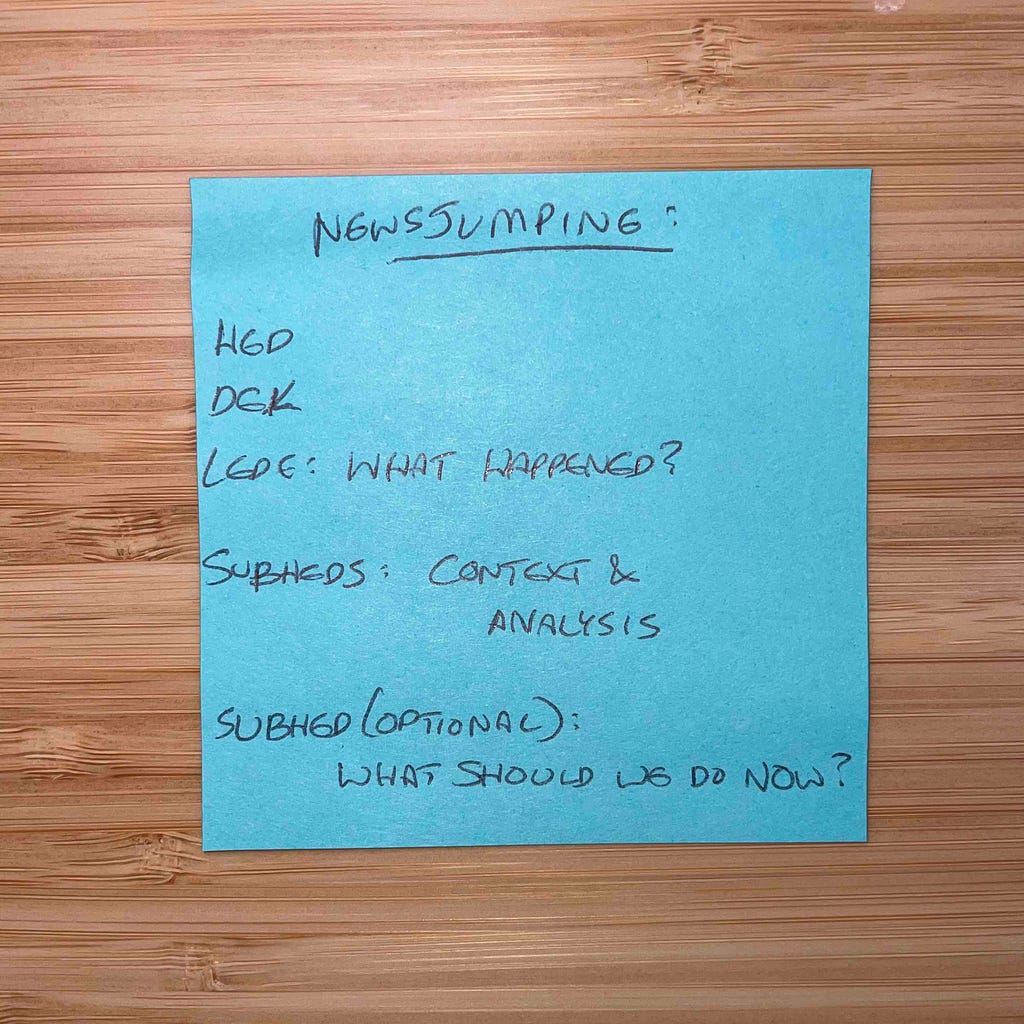 Image from the author.
Image from the author.
Many writers don’t want to watch or keep up on the news. As a former publicist, I can tell you that this will make it harder to get mainstream coverage on your ideas. News outlets want — spoiler alert — news. They want fresh ideas and hot takes on current events.
How to create an email template to help your social media followers flood politicians with messages about the protestsHeadspace's COO Was Just Promoted to CEO After Only 6 Months at the Company. Here's How She Did It.Takeaway: If you can form opinions and write quickly, you’ll often move to the front of the line in editor inboxes.Framework #9: Self-experimentation
Did you not drink caffeine for 30 days? Did you get a pedicure during quarantine? Did you do your own pedicure for the first time, only to have your house catch on fire?! Self-experimentation is an article framework, and hypotheses are cliffhangers by design.
I don’t use this one much, but it might be perfect for you. You don’t have to reinvent the wheel with pieces about personal change because the fact that it’s your unique experience automatically makes it original. Here’s one I found about quitting caffeine. Here’s another. They are both great reads because they are two separate and distinct personal experiences.
Put your content creator hat on with this one. You may need to do some preparatory documentation of the before, during, and after of your experiment for your article to make sense. This could include
Journaling along the wayPhotos or screenshots at the start and finishData. Say it with me: “Numbers are my friends.”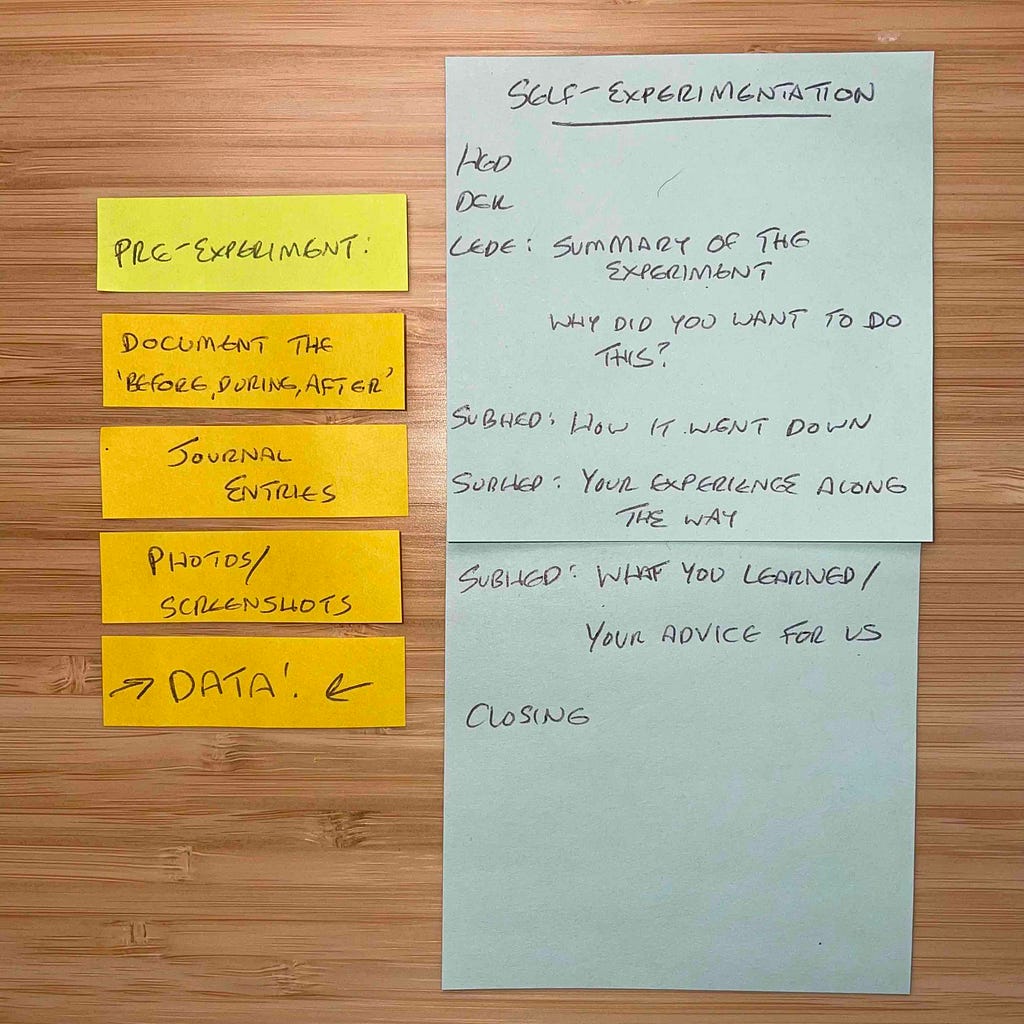 Image from the author.
Image from the author.
When you tell people you conducted an experiment, it automatically creates an open loop. This is a phenomenon called the Zeigarnik effect: Unresolved information sticks in our brains more deeply than resolved information, so you’re pretty much guaranteed more clickthrough and curiosity if you tell people you tried something out.
How I Quit My Job Mid-Pandemic And Made $20,000 In 30 DaysI’ve Beta-Tested 9 Online Products During The Pandemic. Here’s How They’ve PerformedTakeaway: Hypotheses are cliffhangers by design.Final takeaways
If you find yourself getting stuck while writing, it’s not because you have nothing to say or are a mediocre content creator. Consider that it might be time to add new tools to your toolbox or develop more fluency with the ones you already have. Practice using frameworks to organize your thoughts, flesh out your ideas, and you’ll be publishing articles quickly and consistently in no time.
🎉 New For 2021: How do I write 5+ articles/week for websites like Entrepreneur and Fast Company? One word: Templates. I’ve put my best stuff into a 3-resource Article Template Toolkit:
➡️ Grab your free toolkit right here.
9 Article Frameworks I Use To Repeatedly Get Published In Fast Company And Entrepreneur was originally published in The Writing Cooperative on Medium, where people are continuing the conversation by highlighting and responding to this story.
Read more: writingcooperative.com
